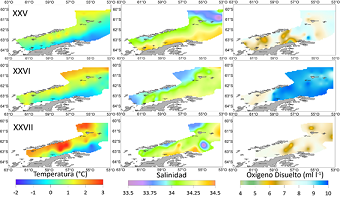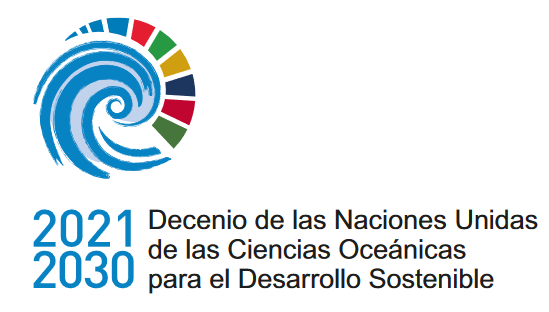Caracterización acústica de las agregaciones de krill (Euphausia superba) detectadas automáticamente en el Estrecho de Bransfield e Isla Elefante
DOI:
https://doi.org/10.47193/mafis.3532022010903Palabras clave:
Hidroacústica, agregaciones, Antártida, ecosonda multifrecuencia SIMRAD EK80, bioestadísticaResumen
En el presente estudio se caracterizaron agregaciones de krill (Euphasia superba) identificadas en el Estrecho de Bransfield y alrededores de la Isla Elefante. Los datos fueron recolectados con una ecosonda multifrecuencia SIMRAD EK80 durante tres veranos australes: 2018, 2019 y 2020. Para la detección de agregaciones de krill se utilizaron dos frecuencias (38 y 120 kHz) y un algoritmo incluido en un programa destinado para el post procesamiento denominado Echoview versión 9, automatizado con el paquete EchoviewR en R. Se detectaron un total de 22.221 agregaciones. Los descriptores acústicos fueron analizados con la correlación de Pearson. Para la caracterización de agregaciones de krill se aplicó un análisis de componentes principales (PCA), seguidamente de un agrupamiento jerárquico. Para determinar las diferencias temporales de los clústeres fue aplicado un análisis de varianza (ANOVA). Además, a las agregaciones de krill se le asignaron las variables ambientales superficiales para aplicarle un modelo generalizado aditivo (GAM). Utilizando las primeras tres dimensiones del PCA (que explicaron 81% de la variabilidad total) se identificaron tres clústeres. El primer clúster se caracterizó por tener agregaciones de krill con menor altura (2 m), bajos valores en el coeficiente de retrodispersión acústica (7 m2 mn-2), y estar ubicado a mayor profundidad (81 m). El segundo clúster tuvo las agregaciones más someras (34 m), de menor longitud (75 m) y compacidad (202). Finalmente, el tercer clúster presentó agregaciones de mayor longitud (849 m), volumen (207.412 m3) y altura (11 m), además de tener elevados valores de retrodispersión acústica (637 m2 mn-2), oblicuidad (6), compacidad (2.436) y coeficiente de variación (213). Espacialmente, el clúster l se localizó con mayor presencia en los alrededores de la Isla Elefante durante el 2018 y 2019, mientras que para este mismo período los clústeres I y II se ubicaron dispersos en toda la zona de estudio, pero focalizados en el Estrecho de Bransfield. Para 2020 se presentaron anomalías térmicas de + 2 °C aproximadamente y hubo una dispersión de los tres clústeres en toda la zona de estudio, donde se observó que el clúster I se localizó con mayor presencia en el Estrecho de Bransfield. Se encontraron diferencias significativas (p < 0,05) entre los clústeres por año. Sin embargo, dichas diferencias no fueron tan marcadas. Mediante un GAM, se estableció que todas las variables para cada clúster fueron significativas (p < 0,05). Las agregaciones se mantuvieron en condiciones promedio de temperatura (0,8 °C), salinidad (34,14) y oxígeno disuelto (8,16 ml l-1). A escala interanual, se observó que las características de las agregaciones no cambiaron.
Descargas
Métricas
Citas
Agnew D. 1992. Distribution of krill (Euphausia superba Dana) catches in the South Shetlands and South Orkneys. Selected scientific papers SC-CAMLR-SSP/9. Hobart: CCAMLR. p. 287-303.
Alonso S, Switzer P, Mangel M. 2003. An ecosystem-based approach to management: using individual behavior to predict the indirect effects of Antarctic krill fisheries on penguin foraging. J Appl Ecol. 40: 692-702.
[AMLR] Antarctic Marine Living Resources. 1998. AMLR 1997/1998 Field Season Report. Objectives, accomplishments and tentative conclusions. En: Martin J, editor. Southwest Fisheries Science Center. Antarctic Ecosystem Research Group, Administrative Report LJ- 98-07. 166 p.
[AMLR] Antarctic Marine Living Resources. 2011. AMLR 2009/2010 Field Season Report. Objectives, accomplishments and tentative conclusions. En: Van Cise A, editor. Southwest Fisheries Science Center. Antarctic Ecosystem Research Division NOAA-TM-NMFS-SWFSC-470. 66 p.
Arntz WE. 1997. Investigación antártica en biología marina: situación actual, proyectos internacionales y perspectivas. Bol R Soc Esp Hist Nat. 93 (1-4): 13-44.
Bar-On Y, Philips R, Milo R. 2018. The biomass distribution on Earth. Proc. Natl Acad Sci USA. 115 (25): 6506-6511.
Barrera-Oro E, Marschoff E, Ainley D. 2017. Changing status of three notothenioid fish at the South Shetland Islands (1983-2016) after impacts of the 1970-80s commercial fishery. Polar Biol. 40 (10): 2047-2054. DOI: https://doi.org/10.1007/s00300-017-2125-0
Brierley A, Cox M. 2010. Shapes of krill swarms and fish schools emerge as aggregation members avoid predators and access oxygen. Curr Biol. 20 (19): 1758-1762. DOI: https://doi.org/10.1016/j.cub.2010.08.041
[CCAMLR] Commission for the Conservation of Antarctic Marine Living Resources. 2000. Report of the B0 Workshop. WG-EMM-00/21 Rev. 1. La Jolla.
[CCAMLR] Commission for the Conservation of Antarctic Marine Living Resources. 2007. Report of the XXVI Meeting of the Scientific Committee. SC-CAMLR-XXVI. Hobart: CCAMLR. 4 p.
Conti S, Demer D. 2006. Improved parameterization of the SDWBA for estimating krill target strength. ICES J Mar Sci. 63 (5): 928-935. DOI: https://doi.org/10.1016/j.icesjms.2006.02.007
Cossio A, Reiss C. 2011. Bioacoustics survey. En: Van Cise A, editor. Field Season Report. Objectives, accomplishments and tentative conclusions. AMLR 2009/2010. Southwest Fisheries Science Center. Antarctic Ecosystem Research Division NOAA-TM-NMFS-SWFSC-470. p. 12-16.
Croxall J, Nicol S. 2004. Management of southern ocean fisheries: global forces and future sustainability. Antarct Sci. 16 (4): 569-584.
De Robertis A, Higginbottom I. 2007. A post-processing technique to estimate the signal-to-noise ratio and remove echosounder background noise. ICES J Mar Sci. 64: 1282-1291.
Demer D, Berger L, Bernasconi M, Bethke E, Boswell K, Chu D, Domokos R, Dunford A, Fässler S, Gauthier S, et al. 2015. Calibration of acoustic instruments. ICES Coop Res Rep. 326. 130 p.
Demer D, Conti S. 2005. New target-strength model indicates more krill in the Southern Ocean. ICES J Mar Sci. 62: 25-32.
Foote K. 1990. Spheres for calibrating an eleven-frequency acoustic measurement system. ICES J Mar Sci. 46: 284-286.
Gascon V, Werner R. 2005. Antarctic krill: a case study on the ecosystem implications of fishing. Puerto Madryn: Lighthouse Foundation, Antarctic and Southern Ocean Coalition. 30 p.
Greene C, Stanton T, Wiebe P, McClatchie S. 1991. Acoustic estimates of Antarctic krill. Nature. 349 (6305): 110-110. DOI: https://doi.org/10.1038/349110a0
Greenlaw C, Johnson R. 1983. Multiple frequency acoustical estimation. Biol Ocean. 2 (2, 3-4): 227-252.
Harrison L, Cox MJ, Skaret G, Harcourt R. 2015. The R package EchoviewR for automated processing of active acoustic data using Echoview.
Helbling E, Amos A, Silva N, Villafane V, Holm-Hansen O. 1993. Phytoplankton distribution and abundance as related to a frontal system north of Elephant Island, Antarctica. Antarctic Sci. (1): 25-36.
Hewitt R, Kim S, Naganobu M, Gutierrez M, Kang D, Takao Y, Quinones J, Leeg YH, Shing H, Kawaguchi S, Emery J, Demer D, Loeb V. 2004. Variation in the biomass density and demography of Antarctic krill in the vicinity of the South Shetland Islands during the 1999/2000 austral summer. Deep-Sea Res (II Top Stud Oceanogr). 51: 1411-1419.
Holm-Hansen O, Hewes CD, Villafañe VE, Helbling EW, Silva N, Amos T. 1997. Distribution of phytoplankton and nutrients in relation to different water masses in the area around Elephant Island, Antarctica. Polar Biol. 18 (2): 145-153. DOI: https://doi.org/10.1007/s003000050169
[IMARPE] Instituto del Mar del Perú. 2020. Estudio del ecosistema pelágico en el Estrecho de Bransfield y alrededores de las Islas Piloto Pardo. Vigésimo Séptima Expedición Científica Peruana a La Antártida: ANTAR XXVII.
Kalinowski J, Witek Z. 1985. Scheme for classifying aggregations of Antarctic krill. Biomass Handbook 27. 9 p.
Kock K. 1991. The state of exploitation fish stocks in the Southern Ocean-A review. Arch Fishchereiwiss. 41 (1): 1-66.
Krafft B, Melle W, Knutsen T, Bagøien E, Broms C, Ellertsen B, Siegel V. 2010. Distribution and demography of Antarctic krill in the Southeast Atlantic sector of the Southern Ocean during the austral summer 2008. Polar Biol. 33 (7): 957-968. DOI: https://doi.org/10.1007/s00300-010-0774-3
Macaulay M. 1987. Biomass estimates of krill in the Bransfield Strait-Elephant Island ecosystem monitoring area of CCAMLR. SC-CAMLR-VI/BG/46.
Meyer B, Atkinson A, Bernard K, Brierley A, Driscoll R, HILL S, Marchoff E, Maschette D, Perry F, Reiss C, et al. 2020. Successful ecosystem-based management of Antarctic krill should address uncertainties in krill recruitment, behaviour and ecological adaptation. Commun Earth Environ. 1 (28). DOI: https://doi.org/10.1038/s43247-020-00026-1
Miller D, Barange M, Klindt H, Murray A, Hampton I, Siegel V. 1993. Antarctic krill aggregation characteristics from acoustic observations in the Southwest Atlantic Ocean. Mar Biol. 117 (1): 171-183. DOI: https://doi.org/10.1007/bf00346440
Murphy E, Morris D, Watkins J, Priddle J. 1988. Scales of interaction between Antarctic krill and the environment. En: Sahrhage D, editor. Antarctic Ocean and resources variability. Berlin, Heidelberg: Springer-Verlag. p. 120-130.
Nowacek D, Friedlaender A, Halpin N, Hazen E, Johnston D, Read A, Espinasse B, Zhou M, Zhu Y. 2011. Super-aggregations of krill and Humpback whales in Wilhelmina Bay, Antarctic Peninsula. PLoS ONE. 6: e19173.
Pinel-Alloul P. 1995. Spatial heterogeneity as a multiscale characteristic of zooplankton community. Hydrobiology. 300: 17-42.
Reid K, Sims M, White RW, Gillon K. 2004. Spatial distribution of predator/prey interactions in the Scotia Sea: implications for measuring predator-fisheries overlap. Deep-Sea Res. 51: 1383-1396.
Reiss C, Cossio A, Santora J, Dietrich K, Murray A, Mitchell B, Walsh J, Weiss E, Gimpel C, Jones C, Watters G. 2017. Overwinter habitat selection by Antarctic krill under varying sea-ice conditions: implications for top predators and fishery management. Mar Ecol Prog Ser. 568: 1-16. DOI: https://doi.org/10.3354/meps12099
Ritz D. 1994. Social aggregation in pelagic invertebrates. Adv Mar Biol. 30: 155-216.
Ritz D. 2000. Is social aggregation in aquatic crustaceans a strategy to conserve energy? Can J Fish Aquat Sci. 57 (S3): 59-67.
Siegel V, Kawaguchi S, Ward P, Litvinov F, Sushin V, Loeb V, Watkins J. 2004. Krill demography and large-scale distribution in the southwest Atlantic during January/February 2000. Deep-Sea Res (II Top Stud Oceanogr). 51 (12-13): 1253-1273. DOI: https://doi.org/10.1016/j.dsr2.2004.06.013
Simmonds E, Maclennan DN. 2005. Fisheries acoustics: theory and practice. 2nd ed. Oxford: Blackwell. 437 p.
Smetacek V, Nicol S. 2005. Polar ocean ecosystems in a changing world. Nature. 437: 362-368. DOI: https://doi.org/10.1038/nature04161
Tarling G, Jarvis T, Emsley S, Matthews J. 2002. Midnight sinking behavior in Calanus finmarchicus, a response to satiation or krill predation? Mar Ecol Prog Ser. 240: 183-194.
Tarling G, Klevjer T, Fielding S, Watkins J, Atkinson A, Murphy E, Korb R, Whitehouse M, Leaper R. 2009. Variability and predictability of Antarctic krill swarm structure. Deep-Sea Res (II Top Stud Oceanogr). 56 (11): 1994-2012. DOI: https://doi.org/10.1016/j.dsr.2009.07.004
Trathan P, Hill S. 2016. The importance of krill predation in the Southern Ocean. En: Siegel V, editor. Biology and ecology of Antarctic krill. Springer. p. 321-350.
Trathan P, Warwick-Evans V, Hinke J, Young E, Murphy E, Carneiro A, Dias M, Kovacs K, Lowther A, Godo O, et al. 2018. Managing fishery development in sensitive ecosystems: identifying penguin habitat use to direct management in Antarctica. Ecosphere. 9: e02392.
Villafañe VE, Helbling EW, Holm-Hansen O. 1993. Phytoplankton around Elephant Island, Antarctica. Polar Biol. DOI: https://doi.org/10.1007/bf00238928
Villafañe VE, Helbling EW, Holm-Hansen W. 1995. Spatial and temporal variability of phytoplankton biomass and taxonomic composition around Elephant Island, Antarctica, during the summers of 1990-1993. Mar Biol. 123 (4): 677-686. DOI: https://doi.org/10.1007/bf00349110
Watkins J, Murray A, Daly H. 1999. Variation in the distribution of Antarctic krill Euphausia superba around South Georgia. Mar Ecol Prog Ser. 188: 149-160. DOI: https://doi.org/10.3354/meps188149
Wiebe P, Greene C, Stanton T, Burczynski J. 1990. Sound scattering by live zooplankton and micronekton: empirical studies with a dual-beam acoustical system. J Acoust Soc Am. 88 (5): 2346-2360.
Zhou M, Dorland R. 2004. Aggregation and vertical migration behavior of Euphausia superba. Deep-Sea Res (II Top Stud Oceanogr). 51 (17-19): 2119-2137. DOI: https://doi.org/10.1016/j.dsr2.2004.07.009

Publicado
Cómo citar
Número
Sección
Licencia
Derechos de autor 2022 Carlos Valdez Mego, Daniel Grados, Luis La Cruz, Gustavo Cuadros, Rodolfo Cornejo, Ramiro Castillo

Esta obra está bajo una licencia internacional Creative Commons Atribución-NoComercial-CompartirIgual 4.0.
Los autores de los artículos publicados en Marine and Fishery Sciences conservan los derechos de autor de sus artículos, a excepción de las imágenes de terceros y otros materiales añadidos por Marine and Fishery Sciences, que están sujetos a los derechos de autor de sus respectivos propietarios. Por lo tanto, los autores son libres de difundir y volver a publicar sus artículos, sujeto a los requisitos de los propietarios de derechos de autor de terceros y sujeto a que la publicación original sea completamente citada. Los visitantes también pueden descargar y reenviar artículos sujetos a los requisitos de citas. La capacidad de copiar, descargar, reenviar o distribuir cualquier material siempre está sujeta a los avisos de derechos de autor que se muestran. Los avisos de copyright deben mostrarse de manera prominente y no pueden borrarse, eliminarse u ocultarse, total o parcialmente. El autoalmacenamiento en servidores y repositorios de preimpresión está permitido para todas las versiones.
Esta revista ofrece a los autores una política de acceso abierto. Los usuarios pueden leer, descargar, copiar, distribuir, imprimir, buscar o vincular los textos completos de los artículos, o usarlos para cualquier otro propósito legal dentro de la licencia Creative Commons 4.0 (BY-NC-SA), sin solicitar permiso previo del editor o del autor. Esto está de acuerdo con la definición BOAI de acceso abierto.
 https://orcid.org/0000-0003-3022-0656
https://orcid.org/0000-0003-3022-0656 https://orcid.org/0000-0001-5184-2740
https://orcid.org/0000-0001-5184-2740 https://orcid.org/0000-0002-2208-4538
https://orcid.org/0000-0002-2208-4538 https://orcid.org/0000-0003-2397-111X
https://orcid.org/0000-0003-2397-111X https://orcid.org/0000-0001-9325-6512
https://orcid.org/0000-0001-9325-6512 https://orcid.org/0000-0003-0580-2742
https://orcid.org/0000-0003-0580-2742


























